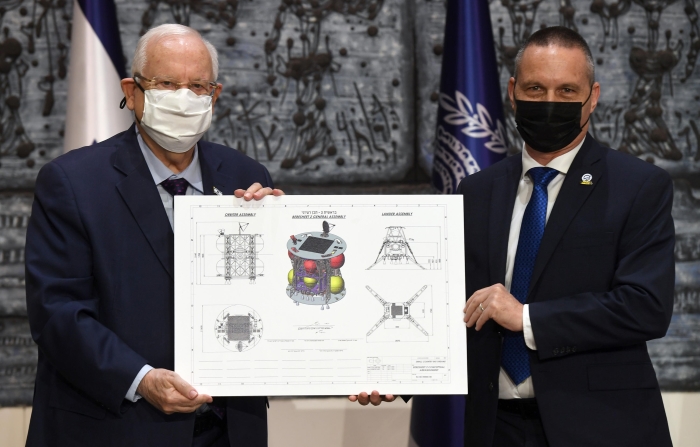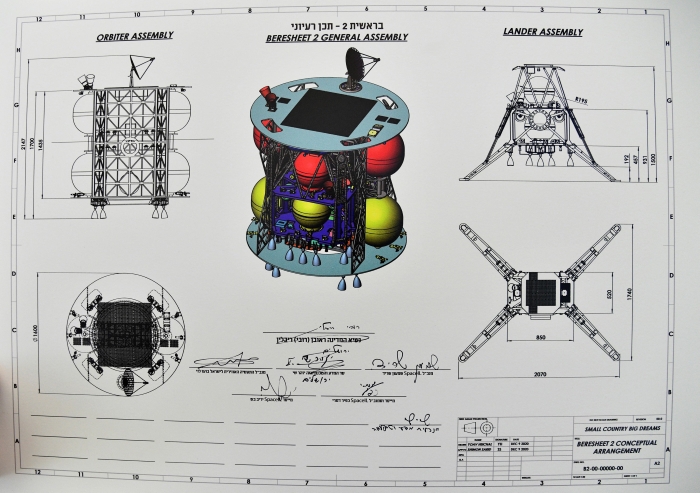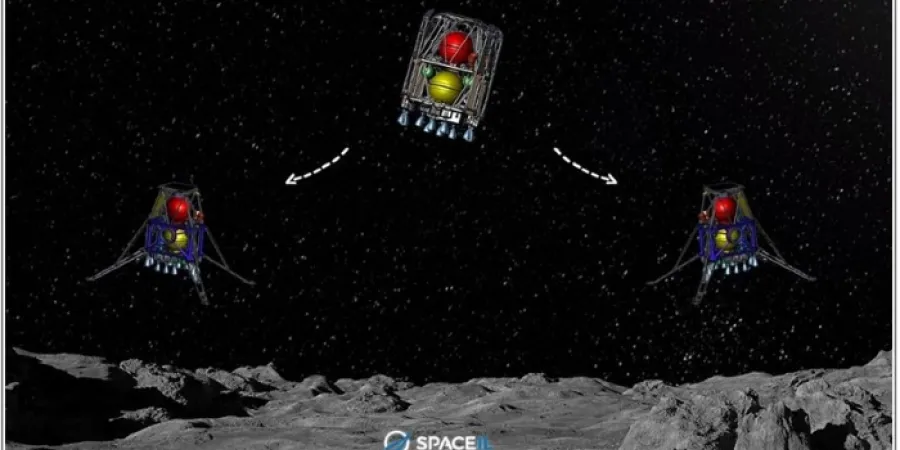Israel launches ambitious 'Beresheet 2' project to put two landers on the moon
According to the plan, a spacecraft with an orbiter and two landers will lift off in 2024. The project is being jointly led by the Israel Space Agency and IAI
IsraelDefense
| 10/12/2020
A ceremony hosted by Israel's President Rueven (Ruvi) Rivlin was held Wednesday at the presidential residence in Jerusalem to mark the launching of the "Beresheet 2" project, aimed at sending a second Israeli spacecraft to the moon.
The Beresheet 2 spacecraft, which will consist of an orbiter and two landers, is currently set to be launched in the first half of 2024. The landers are expected to touch down at two different sites in order to conduct different scientific experiments. The orbiter is to circle the moon for a number of years and be used for scientific experiments and various educational activities.
"Today, we are setting out on a new path, familiar but different," President Rivlin said. "The Beresheet 2 mission to space is unique. If it succeeds – and I am sure it will – this project will extend the boundaries of human knowledge with ground-breaking scientific experiments, helping us to understand better the universe in which we live."
Among those participating in Wednesday's event were Minister of Science and Technology Izhar Shay, CEO of SpaceIL Shimon Sarid, CEO of Israel Aerospace Industries Boaz Levy, as well as the Director General of the Ministry of Science and Technology, Ms. Shai-Lee Spigelman, and the founders of SpaceIL, Kfir Damari and Yariv Bash.
Last year, with the “Beresheet” spacecraft, SpaceIL became the first private organization in history to reach the moon, and in doing so, established the State of Israel as the fourth country to have touched the moon. SpaceIL is a nonprofit established approximately one decade ago which seeks to promote the sciences and scientific education.
With the end of the Beresheet 1 project, SpaceIL’s board of directors decided that the best course of action would be to utilize the “Beresheet effect” and begin work on the Beresheet 2 project. After thorough investigations and drawing of conclusions, the project was formed.
Jointly leading the Beresheet 2 project are the Israel Space Agency, which is part of the Ministry of Science and Technology, and Israel Aerospace Industries. The agency views the project as an extraordinary opportunity to significantly advance the civilian space industry and the study of space in Israel, to expand international collaborations, and to promote science and space subjects among Israeli children and youth. The Israel Space Agency will lead the international collaborations and will establish the necessary ties with the various space agencies. Discussions are already being held with government representatives from a number of countries that have expressed interest in being a part of and supporting the project.
Israel Aerospace Industries (IAI) will lead the development, planning and system engineering efforts of the Beresheet 2 project. All of the system integrations within the spacecraft will be carried out at IAI. These activities will incorporate all of the lessons learned from the development of Beresheet 1 and will implement IAI’s customary quality assurance processes for space projects.
The entire spacecraft is expected to weigh approximately 630 kilograms, with each of the landers weighing roughly 120 kg before landing and roughly 60 kg after landing.
Seeking to include and advance the next generation on a global basis, Beresheet 2 is expected to be a multi-national mission led by Israel, with participation of additional countries. School and university students from the participating countries will be able to study information from the orbiter and use it for further research and experiments.
Leadership of such an international mission is expected to position Israel as a leader in the global civilian space industry, help realize the potential of the space field, and serve as a significant economic growth engine.
Along with the scientific mission intrinsic in the development and launch of the spacecraft to the moon, Beresheet 2 represents an equally significant educational project. Together with SpaceIL, the Israel Space Agency will steward all of the educational activities with a goal of piquing the curiosity of the younger generations to the various scientific disciplines and to promote the values of excellence, social leadership, and groundbreaking initiative.
The budget for the project is approximately $100 million. Roughly half will be funded by the international collaborations formed by the Israel Space Agency, with the rest of the budget to be sourced from various philanthropic contributors and sponsorships.

Israeli President Reuven Rivlin (L) and Minister of Science and Technology Izhar Shay at the ceremony. Photo: IAI

Photo: IAI
According to the plan, a spacecraft with an orbiter and two landers will lift off in 2024. The project is being jointly led by the Israel Space Agency and IAI
A ceremony hosted by Israel's President Rueven (Ruvi) Rivlin was held Wednesday at the presidential residence in Jerusalem to mark the launching of the "Beresheet 2" project, aimed at sending a second Israeli spacecraft to the moon.
The Beresheet 2 spacecraft, which will consist of an orbiter and two landers, is currently set to be launched in the first half of 2024. The landers are expected to touch down at two different sites in order to conduct different scientific experiments. The orbiter is to circle the moon for a number of years and be used for scientific experiments and various educational activities.
"Today, we are setting out on a new path, familiar but different," President Rivlin said. "The Beresheet 2 mission to space is unique. If it succeeds – and I am sure it will – this project will extend the boundaries of human knowledge with ground-breaking scientific experiments, helping us to understand better the universe in which we live."
Among those participating in Wednesday's event were Minister of Science and Technology Izhar Shay, CEO of SpaceIL Shimon Sarid, CEO of Israel Aerospace Industries Boaz Levy, as well as the Director General of the Ministry of Science and Technology, Ms. Shai-Lee Spigelman, and the founders of SpaceIL, Kfir Damari and Yariv Bash.
Last year, with the “Beresheet” spacecraft, SpaceIL became the first private organization in history to reach the moon, and in doing so, established the State of Israel as the fourth country to have touched the moon. SpaceIL is a nonprofit established approximately one decade ago which seeks to promote the sciences and scientific education.
With the end of the Beresheet 1 project, SpaceIL’s board of directors decided that the best course of action would be to utilize the “Beresheet effect” and begin work on the Beresheet 2 project. After thorough investigations and drawing of conclusions, the project was formed.
Jointly leading the Beresheet 2 project are the Israel Space Agency, which is part of the Ministry of Science and Technology, and Israel Aerospace Industries. The agency views the project as an extraordinary opportunity to significantly advance the civilian space industry and the study of space in Israel, to expand international collaborations, and to promote science and space subjects among Israeli children and youth. The Israel Space Agency will lead the international collaborations and will establish the necessary ties with the various space agencies. Discussions are already being held with government representatives from a number of countries that have expressed interest in being a part of and supporting the project.
Israel Aerospace Industries (IAI) will lead the development, planning and system engineering efforts of the Beresheet 2 project. All of the system integrations within the spacecraft will be carried out at IAI. These activities will incorporate all of the lessons learned from the development of Beresheet 1 and will implement IAI’s customary quality assurance processes for space projects.
The entire spacecraft is expected to weigh approximately 630 kilograms, with each of the landers weighing roughly 120 kg before landing and roughly 60 kg after landing.
Seeking to include and advance the next generation on a global basis, Beresheet 2 is expected to be a multi-national mission led by Israel, with participation of additional countries. School and university students from the participating countries will be able to study information from the orbiter and use it for further research and experiments.
Leadership of such an international mission is expected to position Israel as a leader in the global civilian space industry, help realize the potential of the space field, and serve as a significant economic growth engine.
Along with the scientific mission intrinsic in the development and launch of the spacecraft to the moon, Beresheet 2 represents an equally significant educational project. Together with SpaceIL, the Israel Space Agency will steward all of the educational activities with a goal of piquing the curiosity of the younger generations to the various scientific disciplines and to promote the values of excellence, social leadership, and groundbreaking initiative.
The budget for the project is approximately $100 million. Roughly half will be funded by the international collaborations formed by the Israel Space Agency, with the rest of the budget to be sourced from various philanthropic contributors and sponsorships.

Israeli President Reuven Rivlin (L) and Minister of Science and Technology Izhar Shay at the ceremony. Photo: IAI

Photo: IAI



